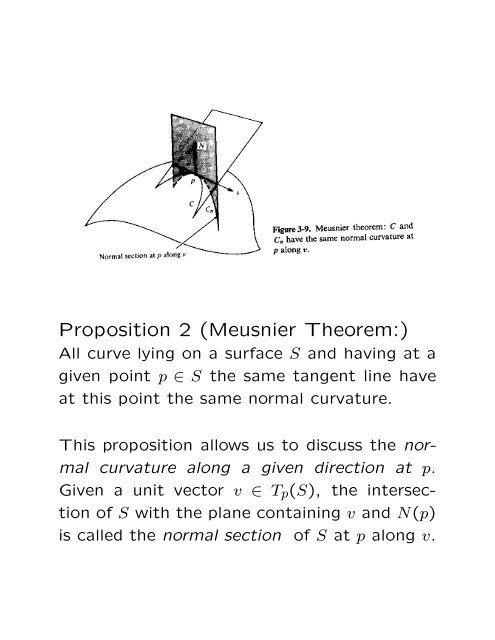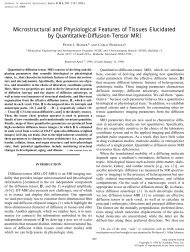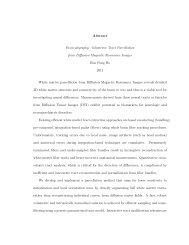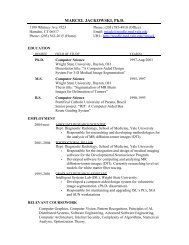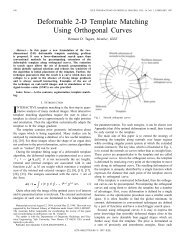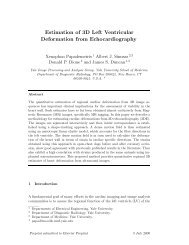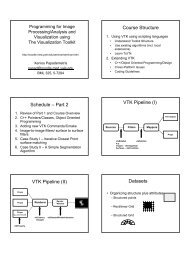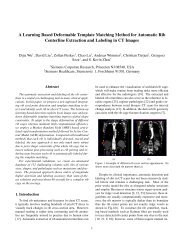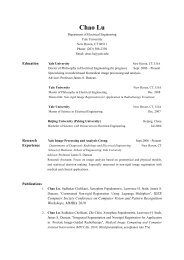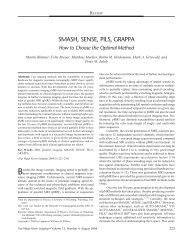Acrobat (.pdf)
Acrobat (.pdf)
Acrobat (.pdf)
Create successful ePaper yourself
Turn your PDF publications into a flip-book with our unique Google optimized e-Paper software.
Proposition 2 (Meusnier Theorem:)<br />
All curve lying on a surface S and having at a<br />
given point p ∈ S the same tangent line have<br />
at this point the same normal curvature.<br />
This proposition allows us to discuss the normal<br />
curvature along a given direction at p.<br />
Given a unit vector v ∈ Tp(S), the intersection<br />
of S with the plane containing v and N(p)<br />
is called the normal section of S at p along v.
Given a self-adjoint linear map A : V → V ,<br />
there exists an orthonormal basis for V such<br />
that relative to that basis the matrix of A is<br />
a diagonal matrix. Furthermore, the elements<br />
on the diagonal are the maximum and the minimum<br />
of the corresponding quadratic form restricted<br />
to the unit circle of V .
For each p ∈ S, there exists an orthonormal basis<br />
{e1, e2} of Tp(S) such that dNp(e1) = −k1e1,<br />
dNp(e2) = −k2e2. Moreover, k1 and k2 (k1 ≥<br />
k2) are the maximum and minimum of the second<br />
fundamental for IIp restricted to the unit<br />
circle of Tp(S); that is, they are the extreme<br />
values of the normal curvature at p.<br />
Definition 7:<br />
The maximum normal curvature k1 and the<br />
minimum normal curvature k2 are called the<br />
principal curvatures at p; the corresponding directions,<br />
that is, the directions given by the<br />
eigenvectors e1 and e2, are called the principal<br />
directions at p.
The knowledge of the principal curvatures at<br />
p allows us to compute the normal curvature<br />
along a given direction of Tp(S). Let v ∈ Tp(S)<br />
with |v| = 1, and since e1 and e2 form an orthonormal<br />
basis of Tp(S), we have<br />
v = e1cosθ + e2sinθ<br />
where θ is the angle from e1 to v in the orientation<br />
of Tp(S). The normal curvature kn<br />
along v is given by the Euler formula:<br />
kn = IIp(v) = − < dNp(v), v ><br />
= − < dNp(e1cosθ + e2sinθ), e1cosθ + e2sinθ ><br />
= < e1k1cosθ + e2k2sinθ, e1cosθ + e2sinθ ><br />
= k1cos 2 θ + k2sin 2 θ<br />
The Euler formula is just the expression of the<br />
second fundamental form in the basis {e1, e2}.
Definition 8:<br />
Let p ∈ S and let dNp : Tp(S) → Tp(S) be the<br />
differential of the Gauss map. The determinant<br />
of dNp is the Gaussian curvature K of S<br />
at p. The negative of half of the trace of dNp<br />
is called the mean curvature H of S at p.<br />
In term of the principal curvatures, we have<br />
K = k1k2<br />
H = k1 + k2<br />
2
Definition 9:<br />
A point of a surface S is called:<br />
• Elliptic: if det(dNp) > 0.<br />
• Hyperbolic: if det(dNp) < 0.<br />
• Parabolic: if det(dNp) = 0, with dNp = 0.<br />
• Planar: if dNp = 0.<br />
Definition 10:<br />
If at p ∈ S, k1 = k2, then p is called an umbilical<br />
point of S; in particular, the planar points are<br />
umbilical points.
Definition 11 (Dupin indicatrix):<br />
Let p be a point in S. The Dupin indicatrix<br />
at p is the set of vectors w of Tp(S) such that<br />
IIp(w) = ±1.<br />
In more convenient form, let (ξ, η) be the Cartesian<br />
coordinates of Tp(S) in the orthonormal<br />
basis {e1, e2}, where e1 and e2 are eigenvectors<br />
of dNp. Given w ∈ Tp(S), let ρ and θ be<br />
the polar coordinates defined by w = ρv, with<br />
|v| = 1 and v = e1cosθ + e2sinθ if ρ = 0. By<br />
Euler formula,<br />
±1 = IIp(w) = ρ 2 IIp(v)<br />
= k1ρ 2 cos 2 θ + k2ρ 2 sin 2 θ<br />
= k1ξ 2 + k2η 2<br />
where w = ξe1 + ηe2. Hence, the Dupin indicatrix<br />
is a union of conics in Tp(S).
• For an elliptic point, the Dupin indicatrix is<br />
an ellipse, and it degenerates into a circle<br />
if the point is an umbilical nonplanar point<br />
(k1 = k2 = 0).<br />
• For a hyperbolic point, the Dupin indicatrix<br />
is made up of two hyperbolas with a common<br />
pair of asymptotic lines (zero normal<br />
curvature).<br />
• For a parabolic point, the Dupin indicatrix<br />
degenerates into a pair of parallel lines.
Definition 12:<br />
Let p be a point in S. An asymptotic direction<br />
of S at p is a direction of Tp(S) for which the<br />
normal curvature is zero. An asymptotic curve<br />
of S is a regular connected curve C ⊂ S such<br />
that for each p ∈ C the tangent line of C at p<br />
is an asymptotic direction.<br />
Definition 13:<br />
Let p be a point in S. Two nonzero vectors<br />
w1, w2 ∈ Tp(S) are conjugate if < dNp(w1), w2 >=<<br />
w1, dNp(w2) >= 0. Two directions r1, r2 at<br />
p are conjugate if a pair of nonzero vectors<br />
w1, w2 parallel to r1 and r2, respectively, are<br />
conjugate.
Gauss Map in Local Coordinates<br />
From here on, all parameterizations x : U ⊂<br />
R 2 → S are assumed to be compatible with<br />
the orientation N of S; that is, in x(U),<br />
N = xu × xv<br />
|xu × xv|<br />
Let x(u, v) be a parameterization at a point<br />
p ∈ S, and let α(t) = x(u(t), v(t)) be a parameterized<br />
curve in S, with α(0) = p.
The tangent vector to α(t) at p is<br />
and<br />
α ′ = xuu ′ + xvv ′<br />
dN(α ′ ) = N ′ (u(t), v(t)) = Nuu ′ + Nvv ′<br />
Since Nu and Nv belong to Tp(S), we may write<br />
and therefore<br />
Nu = a11xu + a21xv<br />
Nv = a12xu + a22xv<br />
dN(α ′ ) = (a11u ′ + a12v ′ )xu + (a21u ′ + a22v ′ )xv<br />
hence,<br />
dN<br />
<br />
u ′<br />
v ′<br />
<br />
=<br />
<br />
a11 a12<br />
a21 a22<br />
<br />
This shows that in the basis {xu, xv}, dN is<br />
given by the matrix (aij) which is not necessarily<br />
symmetric, unless {xu, xv} is an orthonormal<br />
basis.<br />
u ′<br />
v ′
In the basis {xu, xv}, the second fundamental<br />
form is given by<br />
IIp(α ′ ) = − < dN(α ′ ), α ′ ><br />
= − < Nuu ′ + Nvv ′ , xuu ′ + xvv ′ ><br />
= e(u ′ ) 2 + 2fu ′ v ′ + g(v ′ ) 2<br />
where, since < N, xu >=< N, xv >= 0,<br />
e = − < Nu, xu >=< N, xuu ><br />
f = − < Nv, xu >=< N, xuv >= − < Nu, xv ><br />
g = − < Nv, xv >=< N, xvv >
Weingarten Mapping:<br />
The matrix [β] = (aij) in the form<br />
[β] = −<br />
<br />
e f<br />
f g<br />
<br />
E F<br />
F G<br />
−1<br />
is called the Weingarten mapping matrix or the<br />
shape operator matrix of the surface. This matrix<br />
combines the first and second fundamental<br />
forms into one matrix, and determines surface<br />
shape by relating the intrinsic geometry of the<br />
surface to the Euclidean (extrinsic) geometry<br />
of the embedding space.<br />
The Gaussian curvature of a surface can be<br />
obtained from the Weingarten mapping matrix<br />
as its determinant:<br />
eg − f 2<br />
K = det[β] =<br />
EG − F 2<br />
And the mean curvature is similarly half of the<br />
trace of the Weingarten mapping matrix:<br />
H = tr[β]<br />
2<br />
= eG − 2fF + gE<br />
2(EG − F 2 )
Koenderink Shape Index:<br />
The signs of the Gaussian, mean and principal<br />
curvatures are often used to determine basic<br />
surface types and singular points such as<br />
umbilical points. Furthermore, the numerical<br />
relationship between the two principal curvatures<br />
are used in more detailed classification<br />
of surfaces by Koenderink, where a shape index<br />
function is defined as<br />
si = 2<br />
π arctanκ2 + κ1<br />
, (κ2 ≥ κ1)<br />
κ2 − κ1<br />
This way, all surface patches, except for plane<br />
patches where the two principal curvatures equal<br />
zero, are mapped onto si ∈ [−1, +1]. This<br />
shape index function has many nice properties<br />
with regards to the classification of surface<br />
types:<br />
• The shape index is scale invariant, i.e. two<br />
spherical patches with different radii will<br />
have same shape index values.
• Convexities and concavities are on the opposite<br />
sides of the shape index scale, separated<br />
by saddle-like shapes.<br />
• Two shapes from which the shape index<br />
differs only in sign represent complementary<br />
pairs will fit to each other as stamp<br />
and mold if they are of same scale.
spherical trough rut saddle saddle saddle ridge dome spherical<br />
cup rut ridge cap<br />
Surface Type Shape Index Range<br />
Spherical Cup si ∈ [−1, −7/8)<br />
Trough si ∈ [−7/8, −5/8)<br />
Rut si ∈ [−5/8, −3/8)<br />
Saddle Rut si ∈ [−3/8, −1/8)<br />
Saddle si ∈ [−1/8, +1/8)<br />
Saddle Ridge si ∈ [+1/8, +3/8)<br />
Ridge si ∈ [+3/8, +5/8)<br />
Dome si ∈ [+5/8, +7/8)<br />
Spherical Cap si ∈ [+7/8, +1]
Shape Characterization of Discrete<br />
Surfaces<br />
For a regular surface S ⊂ R 3 and p ∈ S, there<br />
always exists a neighborhood V of p in S such<br />
that V is the graph of a differentiable function<br />
which has one of the following three forms:<br />
z = h(x, y)<br />
y = s(x, z)<br />
x = t(y, z)<br />
Hence, given a point p of a surface S, we can<br />
choose the coordinate axis of R 3 such that the<br />
origin O of the coordinates is at p and the z<br />
axis is directed along the outward normal of<br />
S at p (thus, the xy plane agrees with the<br />
tangent plane Tp(S)). It follows that a neighborhood<br />
of p in S can be represented in the<br />
form z = h(x, y), (x, y) ∈ U ⊂ R 2 , where U is<br />
an open set and h is a differentiable function,<br />
with h(0, 0) = 0, hx(0, 0) = 0, hy(0, 0) = 0.
In this case, the local surface is parameterized<br />
by<br />
x(u, v) = (u, v, h(u, v)), (u, v) ∈ U<br />
where u = x, v = y. It can be shown that<br />
xu = (1, 0, hu)<br />
xv = (0, 1, hv)<br />
xuu = (0, 0, huu)<br />
xuv = (0, 0, huv)<br />
xvv = (0, 0, hvv)<br />
Thus, the normal vector at (x, y) is<br />
N(x, y) = (−hx, −hy, 1)<br />
(1 + h 2 x + h2 y )1/2
From the above expressions, it is easy to obtain<br />
the coefficients of the first and second<br />
fundamental forms as<br />
E(x, y) = 1 + h 2 x<br />
F (x, y) = hxhy<br />
G(x, y) = 1 + h 2 y<br />
e(x, y) =<br />
f(x, y) =<br />
g(x, y) =<br />
hxx<br />
(1 + h 2 x + h2 y )1/2<br />
hxy<br />
(1 + h 2 x + h 2 y) 1/2<br />
hyy<br />
(1 + h 2 x + h2 y )1/2<br />
Hence, the curvatures of the surface can be<br />
derived from the Weingarten mapping matrix<br />
computed from these coefficients.


